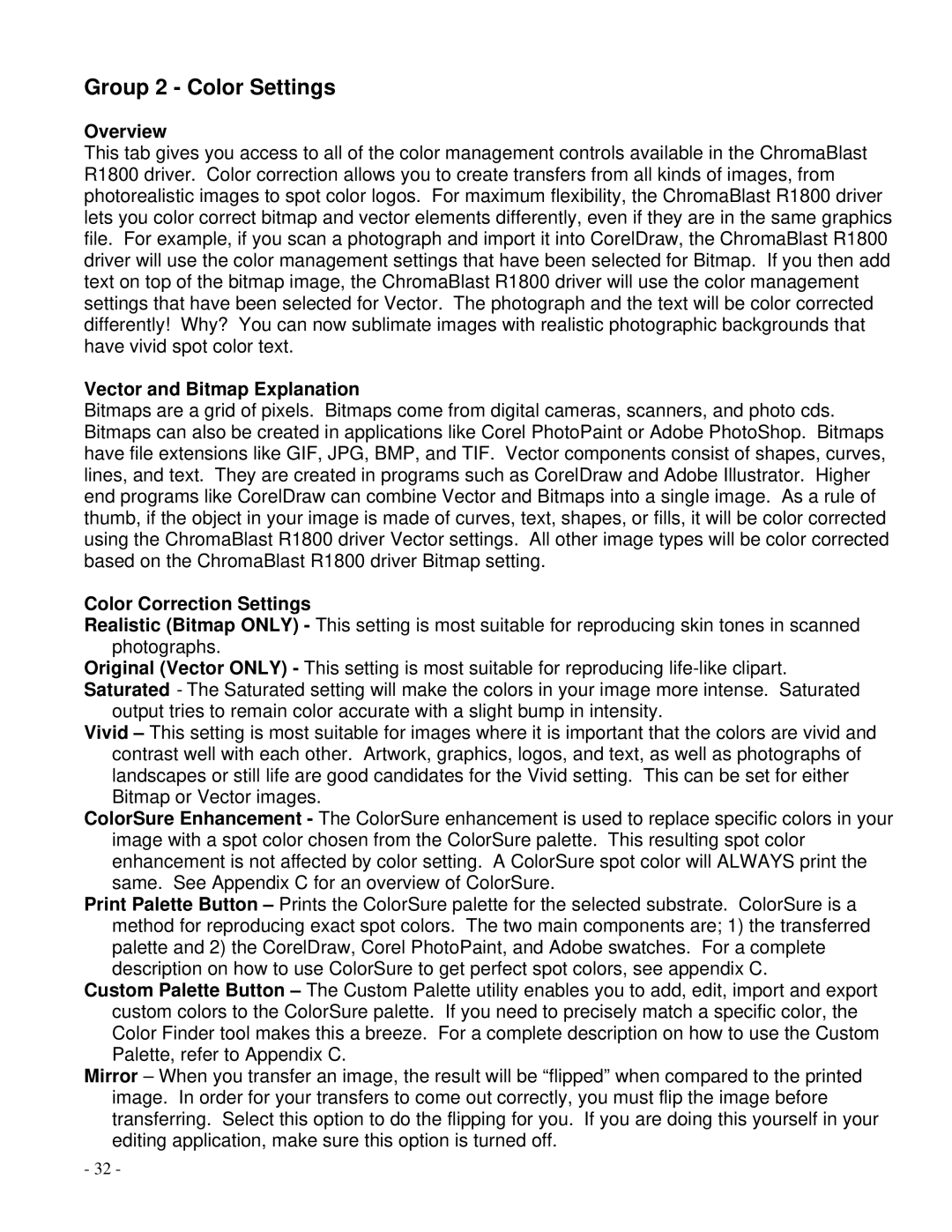Group 2 - Color Settings
Overview
This tab gives you access to all of the color management controls available in the ChromaBlast R1800 driver. Color correction allows you to create transfers from all kinds of images, from photorealistic images to spot color logos. For maximum flexibility, the ChromaBlast R1800 driver lets you color correct bitmap and vector elements differently, even if they are in the same graphics file. For example, if you scan a photograph and import it into CorelDraw, the ChromaBlast R1800 driver will use the color management settings that have been selected for Bitmap. If you then add text on top of the bitmap image, the ChromaBlast R1800 driver will use the color management settings that have been selected for Vector. The photograph and the text will be color corrected differently! Why? You can now sublimate images with realistic photographic backgrounds that have vivid spot color text.
Vector and Bitmap Explanation
Bitmaps are a grid of pixels. Bitmaps come from digital cameras, scanners, and photo cds. Bitmaps can also be created in applications like Corel PhotoPaint or Adobe PhotoShop. Bitmaps have file extensions like GIF, JPG, BMP, and TIF. Vector components consist of shapes, curves, lines, and text. They are created in programs such as CorelDraw and Adobe Illustrator. Higher end programs like CorelDraw can combine Vector and Bitmaps into a single image. As a rule of thumb, if the object in your image is made of curves, text, shapes, or fills, it will be color corrected using the ChromaBlast R1800 driver Vector settings. All other image types will be color corrected based on the ChromaBlast R1800 driver Bitmap setting.
Color Correction Settings
Realistic (Bitmap ONLY) - This setting is most suitable for reproducing skin tones in scanned photographs.
Original (Vector ONLY) - This setting is most suitable for reproducing
output tries to remain color accurate with a slight bump in intensity.
Vivid – This setting is most suitable for images where it is important that the colors are vivid and contrast well with each other. Artwork, graphics, logos, and text, as well as photographs of landscapes or still life are good candidates for the Vivid setting. This can be set for either Bitmap or Vector images.
ColorSure Enhancement - The ColorSure enhancement is used to replace specific colors in your image with a spot color chosen from the ColorSure palette. This resulting spot color enhancement is not affected by color setting. A ColorSure spot color will ALWAYS print the same. See Appendix C for an overview of ColorSure.
Print Palette Button – Prints the ColorSure palette for the selected substrate. ColorSure is a method for reproducing exact spot colors. The two main components are; 1) the transferred palette and 2) the CorelDraw, Corel PhotoPaint, and Adobe swatches. For a complete description on how to use ColorSure to get perfect spot colors, see appendix C.
Custom Palette Button – The Custom Palette utility enables you to add, edit, import and export custom colors to the ColorSure palette. If you need to precisely match a specific color, the Color Finder tool makes this a breeze. For a complete description on how to use the Custom Palette, refer to Appendix C.
Mirror – When you transfer an image, the result will be “flipped” when compared to the printed image. In order for your transfers to come out correctly, you must flip the image before transferring. Select this option to do the flipping for you. If you are doing this yourself in your editing application, make sure this option is turned off.
- 32 -
